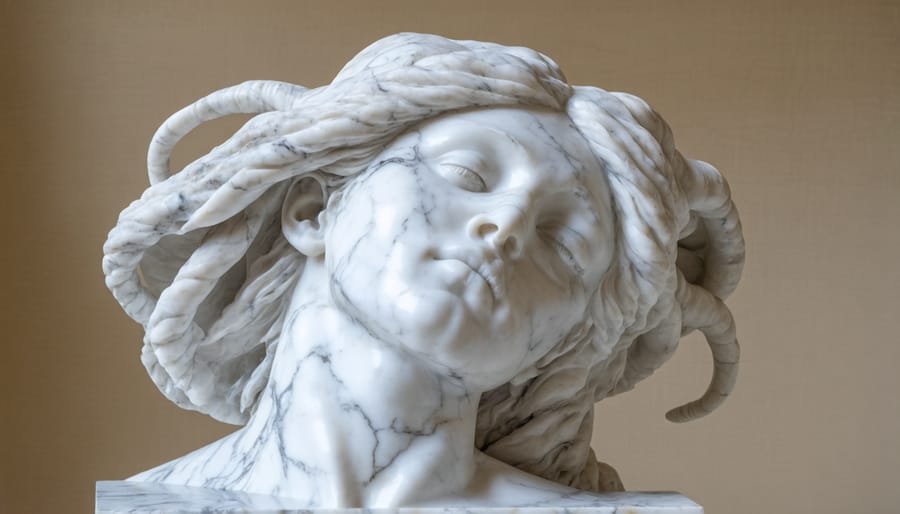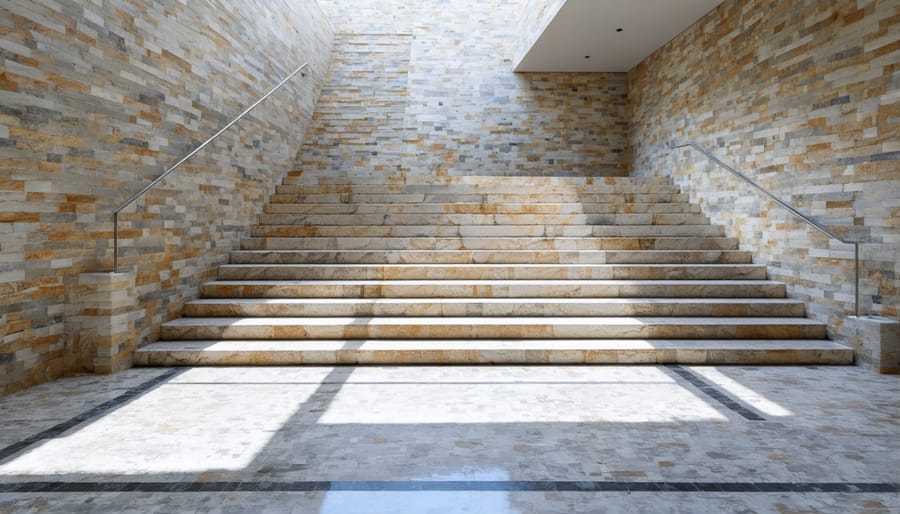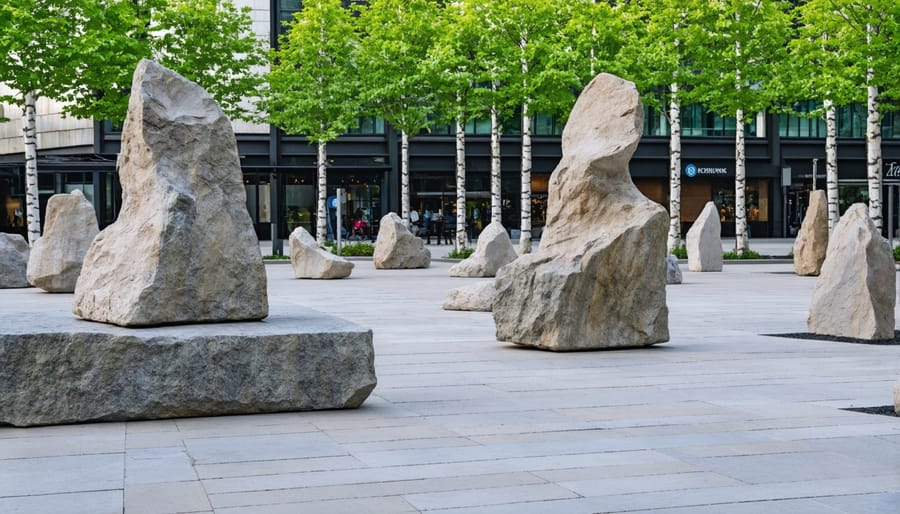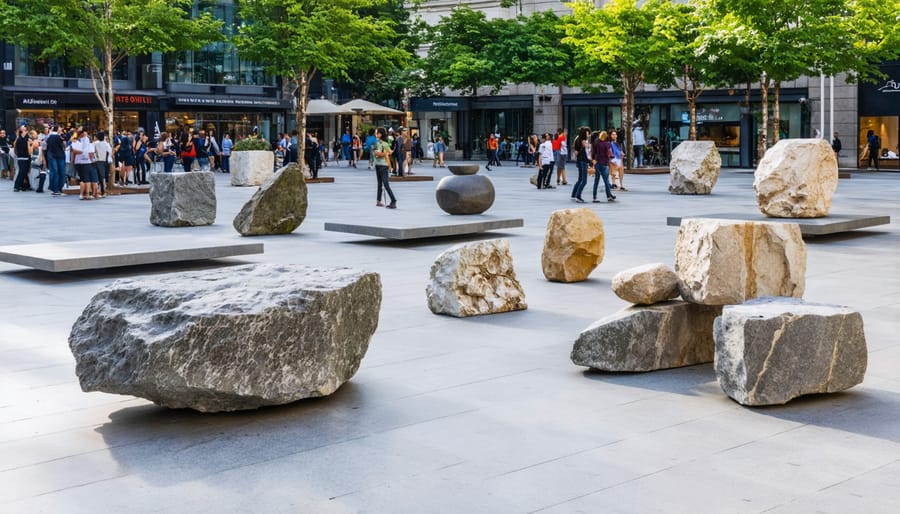Natural stone transcends mere building material to become a profound artistic medium, capturing Earth’s raw beauty in sculptural forms that span millennia. From ancient petroglyphs to contemporary installations, the transformative power of natural stone continues to shape our cultural landscapes and architectural heritage. Artists and craftsmen harness the unique textures, colors, and patterns inherent in limestone, granite, and marble to create works that bridge the gap between nature and human creativity.
Modern stone artisans combine traditional hand-carving techniques with advanced digital fabrication, pushing the boundaries of what’s possible with this timeless medium. Their works grace public spaces, cultural institutions, and private collections worldwide, serving as testament to both geological processes spanning millions of years and human artistic innovation. This intersection of natural beauty and artistic vision produces sculptures, installations, and architectural elements that connect us viscerally to the earth while expressing contemporary aesthetic sensibilities.
The Timeless Appeal of Natural Stone in Artistic Expression
Material Properties That Inspire Artists
Natural stone captivates artists through its inherent characteristics that can’t be replicated by artificial materials. Each stone possesses unique patterns, veining, and color variations formed over millions of years, providing artists with an organic canvas that tells its own story. The material’s diverse textures, from rough-hewn granite to silky-smooth marble, offer tactile experiences that inspire both visual and sculptural works.
The translucency of certain stones, like alabaster and onyx, allows light to penetrate and create ethereal effects, while the density of materials like basalt and granite enables artists to create bold, enduring sculptures. Natural stone’s ability to weather and age gracefully adds another dimension to artistic expression, as pieces evolve over time, developing patinas and subtle color changes that enhance their beauty.
Artists are particularly drawn to stone’s durability and permanence, knowing their creations can potentially last for centuries. The material’s natural cleavage planes and grain patterns guide sculptors in their work, while its varied hardness levels allow for different carving techniques, from delicate detail work to bold structural forms.
The Interplay of Light and Texture
Natural stone’s relationship with light creates an ever-changing artistic display that transforms spaces throughout the day. As sunlight moves across stone surfaces, it reveals intricate patterns, subtle color variations, and textural depths that might otherwise go unnoticed. The interplay between light and stone’s natural characteristics produces shadows, highlights, and dramatic contrasts that enhance its artistic impact.
Different stone finishes interact uniquely with light. Polished surfaces reflect light dramatically, creating mirror-like effects and emphasizing the stone’s crystalline structure. Honed finishes offer a softer, more diffused reflection that brings out the material’s natural depth. Rough-textured or split-face stones create dynamic shadow patterns that shift with changing light conditions.
The positioning of natural stone in relation to light sources significantly impacts its artistic expression. Strategic placement near windows or artificial lighting can emphasize specific features, while grazing light along textured surfaces creates dramatic shadow play. This dynamic relationship between stone and light transforms static installations into living artwork that evolves throughout the day, offering viewers constantly changing perspectives and experiences.

Contemporary Natural Stone Art Techniques
Sculpture and Relief Work
Contemporary stone sculpting combines traditional craftsmanship with modern technology to create stunning artistic works. Artists employ a range of techniques, from hand-carving with chisels and hammers to using advanced pneumatic tools and diamond-tipped implements for precise detailing. The process typically begins with rough cutting to establish the basic form, followed by progressive refinement using increasingly finer tools.
Relief work, where designs emerge from a flat stone surface, requires careful planning and execution. Artists often start by creating detailed sketches or digital designs, then transfer these patterns to the stone surface. The background is carefully removed to create varying depths, producing a three-dimensional effect while maintaining the structural integrity of the stone.
Modern sculptors frequently utilize computer-aided design (CAD) and CNC machinery for initial rough cuts, particularly in large-scale projects. However, the final detailing and surface finishing are still predominantly done by hand, ensuring the artistic touch remains present in each piece. Popular stone choices include marble for its translucent qualities, granite for durability, and limestone for its workability.
Surface treatments vary depending on the desired effect, ranging from high-polish finishes that highlight the stone’s natural patterns to textured surfaces that create visual and tactile interest. Contemporary artists often combine different finishing techniques within a single piece to achieve dramatic contrasts and enhance the overall artistic impact.
Mosaic and Inlay Innovation
Contemporary artists and designers are revolutionizing traditional mosaic techniques through innovative applications and modern stone design techniques. Digital technology now allows for precise cutting and intricate pattern creation, enabling artists to achieve previously impossible designs. Computer-aided design (CAD) software helps visualize complex layouts before stone cutting begins, reducing waste and ensuring perfect execution.
Today’s mosaics often combine different stone types with unconventional materials like metal, glass, and recycled elements, creating stunning hybrid compositions. Artists are experimenting with three-dimensional effects, incorporating varying stone depths and textures to add visual interest and tactile appeal. LED lighting integration within stone mosaics has emerged as a popular trend, transforming static installations into dynamic, mood-setting pieces.
Sustainable practices have also influenced modern mosaic work, with artists utilizing stone remnants and developing zero-waste approaches to material usage. Water-jet cutting technology allows for precise stone shaping while minimizing material waste, making complex geometric patterns more accessible and environmentally conscious.
These innovations have expanded the possibilities for architectural integration, allowing mosaics to serve both decorative and functional purposes in contemporary spaces. From interactive public art installations to sophisticated commercial environments, modern mosaic work continues to push the boundaries of traditional stone artistry while honoring its historical roots.
Natural Stone Art in Public Spaces
Museum and Gallery Installations
Natural stone art installations in museums and galleries showcase the extraordinary potential of stone as a medium for artistic expression. The Guggenheim Museum in Bilbao features Richard Serra’s massive weathering steel and limestone sculptures that create an immersive experience for visitors, demonstrating how natural stone can transform architectural spaces.
The British Museum houses numerous historical stone artifacts and contemporary installations, including Anish Kapoor’s striking granite sculptures that challenge traditional perceptions of stone art. These pieces exemplify how modern artists continue to push the boundaries of stone manipulation while honoring ancient techniques.
Notable gallery installations include the DeCordova Sculpture Park and Museum’s outdoor collection, where natural stone artworks are thoughtfully integrated with the landscape. Artists like Andy Goldsworthy have created site-specific installations that blend seamlessly with their environment, using local stone to tell stories about place and time.
The Storm King Art Center in New York’s Hudson Valley presents monumental stone sculptures that demonstrate the material’s versatility in large-scale outdoor art. These installations often incorporate environmental elements, allowing natural weathering processes to become part of the artistic expression.
Many contemporary museums also feature interactive stone installations that invite visitor participation, breaking down traditional barriers between art and audience. These exhibitions often combine natural stone with other materials like glass, metal, or light, creating multi-sensory experiences that highlight stone’s unique properties and cultural significance.

Urban Landscape Integration
Natural stone art has become an integral element in modern urban design, transforming city spaces into engaging cultural landscapes. From sculptural installations to functional seating areas, these artistic expressions create meaningful connections between built environments and their communities. Cities worldwide are increasingly incorporating outdoor stone installations to enhance public spaces and create distinctive local identities.
Notable examples include the serpentine stone walls in Chicago’s Millennium Park and the granite sculptures dotting Seattle’s Olympic Sculpture Park. These installations serve multiple purposes: they provide aesthetic value, create gathering spaces, and often incorporate sustainable design principles. Urban planners and artists collaborate to ensure these stone artworks complement existing architecture while introducing natural elements into concrete-dominated cityscapes.
The durability of natural stone makes it particularly suitable for public art, requiring minimal maintenance while withstanding various weather conditions and heavy foot traffic. Many contemporary urban stone installations also incorporate interactive elements, encouraging public engagement and creating memorable experiences for visitors. Water features, textured surfaces, and carefully planned lighting enhance these stone artworks, transforming them from static displays into dynamic elements of the urban fabric.
Local stone varieties are often chosen for these projects, establishing a strong connection to regional geology and cultural heritage while reducing transportation costs and environmental impact. This thoughtful integration of natural stone art helps create more livable, engaging urban environments that resonate with both residents and visitors.

Sustainability and Conservation in Stone Art
Sustainable Sourcing Practices
In today’s environmentally conscious world, sustainable stone practices have become essential in natural stone art creation. Responsible artists and craftsmen carefully select quarries that implement controlled extraction methods and land rehabilitation programs. These practices ensure minimal environmental impact while preserving natural resources for future generations.
Ethical sourcing involves working with certified quarries that maintain strict environmental standards and fair labor practices. Artists often choose local stone sources when possible, reducing transportation emissions and supporting regional economies. Many contemporary stone artists also incorporate recycled or salvaged stone into their work, giving new life to materials that might otherwise go to waste.
Documentation of stone origin and certification has become standard practice, allowing artists to trace their materials back to responsible sources. This transparency helps maintain accountability throughout the supply chain and ensures that natural stone art pieces contribute to environmental conservation rather than depletion. Some artists even collaborate with quarries to utilize off-cuts and remnants, maximizing resource efficiency while creating unique artistic expressions.
Preservation Techniques
Proper preservation of stone artwork is crucial for maintaining its aesthetic value and structural integrity over time. Regular cleaning with pH-neutral solutions helps prevent the accumulation of dirt and pollutants that can damage the stone’s surface. For outdoor installations, applying appropriate sealants creates a protective barrier against weathering and environmental factors while allowing the stone to breathe naturally.
Climate control plays a vital role in indoor preservation, as fluctuations in temperature and humidity can cause stone deterioration. Maintaining consistent environmental conditions helps prevent cracking and mineral migration. Professional conservators recommend annual inspections to identify potential issues early and implement preventive measures.
Documentation of the artwork’s condition through detailed photographs and reports ensures proper tracking of changes over time. When damage occurs, specialized restoration techniques such as consolidation or micro-grouting should only be performed by qualified professionals. For valuable pieces, creating a comprehensive preservation plan that includes emergency response protocols can help safeguard the artwork for future generations.
Natural stone art stands as a testament to humanity’s enduring connection with the earth’s raw materials, bridging our ancient heritage with contemporary artistic expression. As we look to the future, the role of natural stone in cultural spaces continues to evolve, incorporating innovative techniques while honoring traditional craftsmanship. The timeless appeal of stone art lies not only in its aesthetic beauty but also in its inherent sustainability and durability, making it an increasingly valuable medium in our environmentally conscious world.
The integration of natural stone art in modern cultural spaces has demonstrated its remarkable versatility, from sculptural installations to architectural elements that blur the line between form and function. As digital technologies advance, artists and craftspeople are finding new ways to push the boundaries of stone artistry while maintaining the material’s authentic character. This synthesis of traditional methods and contemporary innovation ensures that natural stone art remains relevant and compelling for future generations.
Looking ahead, the cultural significance of natural stone art appears poised for continued growth. Its ability to create meaningful connections between people and places, combined with its environmental credentials and lasting durability, positions it uniquely in the realm of public art and cultural expression. As our society increasingly values sustainable, authentic materials with cultural resonance, natural stone art will undoubtedly continue to shape our collective spaces and artistic legacy for centuries to come.










